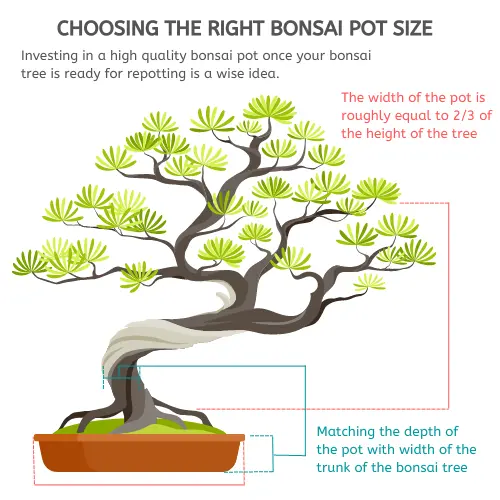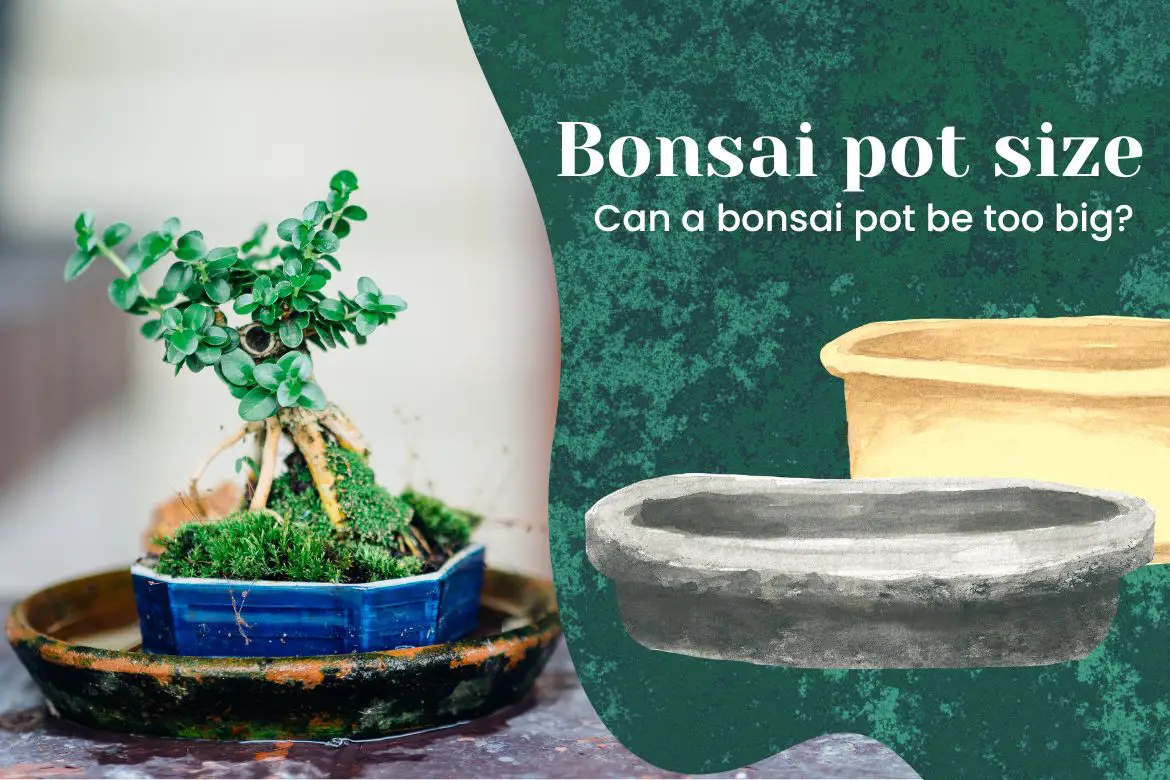The art of bonsai involves more than just growing plants, it also involves understanding a variety of other disciplines, which all work together to create the bonsai. Please read: bonsai rules. By accepting the definition of bonsai as a plant in a container, it becomes evident that the container is a vital part of bonsai’s life.
Choosing the right container for your bonsai is in fact one of the first things you should consider. Read How to choose a bonsai container for your bonsai.
Furthermore, apart from the size of the container, bonsai pot color and bonsai pot material is also an important consideration. All these factors change as the type of bonsai tree changes.
How big should my bonsai pot be?

As a general rule of thumb, the depth of the pot should match the width of the trunk and the length of the pot should be roughly equal to (or slightly larger) 2/3 of the height of the bonsai tree.
What is the rule for bonsai pots?

- For bonsai trees that have a strong horizontal spread i.e. the width of the tree is greater than the height of the tree, the length of the bonsai pot should be two-thirds (2/3) of the width of the tree. (or slightly bigger)
- For bonsai trees that have mainly vertical emphasis (height is greater than the width), the length of the bonsai pot should be two-thirds (2/3) of the height of the tree. (or slightly bigger)
- The depth of the bonsai pot should be equal to the thickness of the trunk of the tree.
As an example, if the tree (with vertical emphasis) is 15 inches tall, the pot should be 10 inches wide. If the tree (with horizontal emphasis) is 18 inches wide, the pot should be 12 inches wide.
Can a bonsai pot be too big?
Some bonsai enthusiasts (especially beginners) might wonder if a bonsai pot can ever be too big. After all, larger pots provide more space for roots to grow and can be more forgiving when it comes to watering and fertilization. However, in the case of bonsai, selecting the right size of bonsai pot for your bonsai is crucial.
Together, the container and plant should create a harmonious effect. This means the pot must be proportionate to the plant’s size and shape i.e. the tree’s height and spread. Also, in practical terms, the bonsai pot must form an adequate reservoir for soil and water.
A bonsai container that is too small for the tree will present an unbalanced appearance. In addition, it creates an unstable base for the tree. In the same way, a bonsai container that is too large will not provide the visual balance necessary for bonsai. Furthermore, the idea of keeping a relatively small pot for a bonsai is to restrict the tree’s growth. If planted in a too large pot, the tree might grow beyond the size that is desired.
How do I know if my bonsai needs a bigger pot?
Knowing when to repot your bonsai into a bigger pot can be tricky, as it depends on several factors such as the age of your bonsai, watering routine, and its growth rate. Please refer to when to repot a bonsai tree for more details. Here are some factors/signs to look out for that may indicate that your bonsai needs a bigger pot:
- If you need to grow the size of your tree: This is one of the main reasons why you would want to repot your bonsai in a bigger pot. If you decide to increase the size of your mature bonsai, you will have to repot it in a larger pot. Also, young bonsai trees that are maturing will need repotting in bigger pots. If your tree has achieved its final shape and size, you will not need to repot the tree in a bigger pot.
- Slow growth of the tree and decline in tree’s health: If your bonsai has been growing slowly or not at all, it may be a sign that the roots have outgrown the current pot and are struggling to absorb enough nutrients and water.
- Roots growing out of the drainage holes: If you notice roots poking out of the drainage holes in your bonsai’s pot, it’s a sign that the current pot is too small and the roots need more space to grow.
- Watering more frequently: If you find yourself needing to water your bonsai more frequently than usual, it may be a sign that the pot is too small and the soil is drying out quickly due to the lack of space for water retention. Continue reading How to water a bonsai tree
- Difficulty watering: If you’re having difficulty watering your bonsai because the water is running off the surface of the soil instead of being absorbed, it may be a sign that the roots have taken up most of the available space in the pot. Also, the drainage of water from the drainage holes will be slow.
- Pot bound roots: If the roots of the tree are pot bound, you will need to prune the roots of the bonsai and repot it in the same pot or repot the tree in a bigger pot. Continue reading how to repot a bonsai for a guide on root pruning and repotting.
- Tree not responding well to fertilizers: Because there is no space left in the soil due to dense root system, the tree will have a hard time absorbing the nutrients from the fertilizer.
Does pot size matter for bonsai?
Yes, the pot size does matter for bonsai trees. Selecting the appropriate pot size is an important consideration in bonsai cultivation and can have significant effects on the health and development of the tree.
The size of the pot directly impacts the available space for the roots of the bonsai tree. A pot that is too small will restrict root growth, potentially leading to root binding and limited nutrient uptake. This can cause the tree to become stunted and unhealthy over time. On the other hand, a pot that is too large may result in excessive root growth, which can be challenging to maintain and may affect the overall balance and aesthetics of the bonsai.
The right pot size strikes a balance between providing adequate space for root growth and allowing for proper maintenance and care. It should be proportionate to the size and age of the tree, providing sufficient room for the roots to develop and spread naturally.
Choosing the correct pot size also depends on the bonsai style and the stage of development of the tree. For younger trees that are still in the training phase, it is common to use slightly larger pots to encourage vigorous growth. As the tree matures and achieves the desired form, it is often repotted into smaller pots to refine the root structure and enhance the overall aesthetics of the bonsai.
To summarize, selecting the right pot size is crucial for bonsai tree health, development, and overall appearance. It should provide an appropriate environment for root growth while aligning with the bonsai tree’s style and stage of development.


